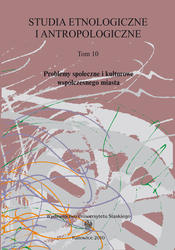

The author of the article raises the issue of changes taking place in the urban space of Będzin and their influence on man. She wonders if the inhabitants of Będzin feel connected with their city, identify with it or if the current spacious urbanist system of the city influences their attitude. Which streets, districts and elements of architecture are the inhabitants of Będzin mostly attached to? Which of these do they consider as symbols and why? Is their attitude influenced by their knowledge of history and culture of the area of living? The work also deals with the problem of the influence of the urban space transformation on the continuity of tradition, self identification and sense of identity of people from Będzin. In order to gain the information on the influence of the urban space on the identity of people living in Będzin, the author presents a spacious urbanist development of the city over centuries. Next, on the basis of the studies and conversations with the inhabitants, she raises the issue of “islandness” of the urban buildings, the separation or even a partial separation of both urban and suburban districts. She pays attention to important and considered to be central or symbolic spaces or buildings in the city which, according to the inhabitants of Będzin, though precious and valuable (e.g. historical), are often neglected, little attractive or mismanaged by the government. Although the inhabitants of Będzin, in majority, are attached to their city, they see its lacks and imperfections. However, many people place family bonds, friends in the first place. Only later on do they place their attachment to the city. The author, on the basis of the studies, states that currently, a small influence on the sense of bond with the city among the inhabitants of Będzin is ascribed to the traditional culture. Many of them cannot even show its elements, such as customs, beliefs, songs, dances, etc. Taking everything into consideration, the author states that the process of searching for one’s own identity by the inhabitants of Będzin has just started, and its course is conditioned by not only the historical past and economic factors, but also to a large extent the urbanist — spacious structure of the city, the urban space shaped by inhabitants and shaping them as such.
Download files
Citation rules

Vol. 10 (2010)
Published:
 10.31261/SEIA
10.31261/SEIA